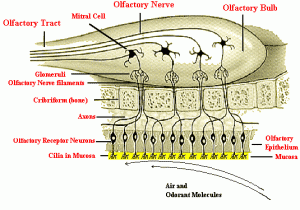The Development and Precision of the Olfactory System
by Matt Litzsinger
The Development and Precision of the Olfactory System
The human brain is an incredibly dense and complicated organ which has allowed the human race an evolutionary advantage throughout our history. It allows us to develop and use tools, modify our environment to suit our needs, and outsmart prey; however, all that brain power comes with a serious drawback: very sensitive and slow development. Very specific stimuli are crucial for the development of different brain systems, especially during a particularly sensitive period known as the critical period. The critical period is a period at the beginning of one’s life where sufficient stimulation is critical in order to ensure healthy brain development, and varies for different brain systems, but most are within the first three years of life (Popli 2013). If inadequate stimuli are experienced during that period, the brain won’t develop properly, and these improper developments are likely permanent. It is thought that the olfactory system does not have a critical period in the same way that other brain systems do, which could spell important implications for develop of human olfactory systems, as well as understanding the rise of development of allergies, as exposure to certain toxins in the critical period might play a role in developing allergies. Researchers at the Stowers Institute for Medical Research sought to discover whether or not the olfactory system has a critical period, and if so, the length of such a period, and finally, if the olfactory system map has the ability to regenerate itself, using gene therapy to manipulate olfactory development before and after birth.
The sense of smell is an extremely nebulous field of study, and there’s still much we don’t know about it. It’s crucial to our survival, as it allows us to detect rancid or poisonous food. Therefore, accurately detecting the harmfulness of odors with a small number of particles is critical. New studies have estimated that humans can detect around one million different odors, many more than previously thought, and that this subtle detection could happen through quantum tunneling. Quantum tunneling simply means that particles can pass through barriers that the laws of classical mechanics don’t allow. In other words, the neurons in the nose (called olfactory sensory neurons, or OSNs for short) are able to detect molecular vibrations rather than simply chemical composition and structure. This was tested by switching normal Hydrogen (hydrogen with 0 neutrons) with deuterium (hydrogen with 1 neutron). Because electrons govern most bonding behavior and chemical interactions, and the number of electrons is not changing, the way that the odor binds with the OSNs should not change. However, due to the extra neutron, the molecular vibration is altered, and according to the study, there was a difference detectable by the olfactory system.
The olfactory system is the only system where neurons are in direct contact with stimuli. With other systems, such as the skin, signals propagate through tissue before reaching the neuron. However, with the olfactory system, odor particles bind directly to receptors. These receptors, or OSNs, bind to odors in the lining of the nose, and relay signals to a glomerulus, located in the olfactory bulb of the brain, which comprise an “odor map,” which makes up the associations required to further process odors. The structure of these glomeruli develops around the time of birth in mice in response to stimuli, but is always changing because of the short lifespan of OSNs.
Researchers at the Stowers Institute for Medical Research genetically engineered a gene which disrupts glomeruli structural formation. After a prenatal period (time in the womb) spent normally, without the disruptor gene, glomeruli were able to form normally, even after switching on the gene right after birth. This suggests that if the network of glomeruli is allowed to form normally, it can be regenerated upon return to normal conditions. However, if the prenatal period is spent with the disruptor gene on past day 5 after birth, then turned off, the glomeruli structure cannot reform normally. With these two studies, we understand that the critical period of the olfactory system lies between conception and 5 days after birth. After this period, the olfactory system is thought to be largely unchangeable. On the other hand, some researchers at the University of Michigan found a way to restore the sense of smell to mice that had lost it. They used the protein IFT88, which is involved in the mutation not allowing the mice to smell, and injected the protein using a deadened common cold virus, which then replicated and introduced the protein to the mice, allowing the olfactory system to work again. These conflicting results show that much more research is needed on this field of olfactory critical periods in order to fully understand the development of the olfactory system and its effects.
Works Cited
Britto PR, Pérez-Escamilla R. No second chances? Early critical periods in human development (2013). Soc Sci Med, 97, pp. 238-40. DOI: 10.1016/j.socscimed.2013.09.001 <http://www.sciencedirect.com/science/article/pii/S0277953613005078>.
Cheetham Claire E, Belluscio Leonardo. An Olfactory Critical Period (2014). Science 344, pp. 157-58. DOI: 10.1126/science.1253136 <http://www.sciencemag.org/content/344/6180/157.full>.
geralt. “Star Golden Christmas Connection Structure Braid.” Photograph. Pixabay. 27 November 2007. Accessed 16 April 2014.
Leffingwell, John C. Olfaction. Photograph. 7 April 2009. Leffingwell & Associates. Accessed 16 April 2014.
Popli et al. G. Popli, D. Gladwell, A. Tsuchiya. Estimating the critical and sensitive periods of investment in early childhood: A methodological note (2013). Social Science & Medicine, 97, pp. 316–24. DOI: 10.1016/j.socscimed.2013.03.015 <http://www.sciencedirect.com/science/article/pii/S0277953613001779>.


